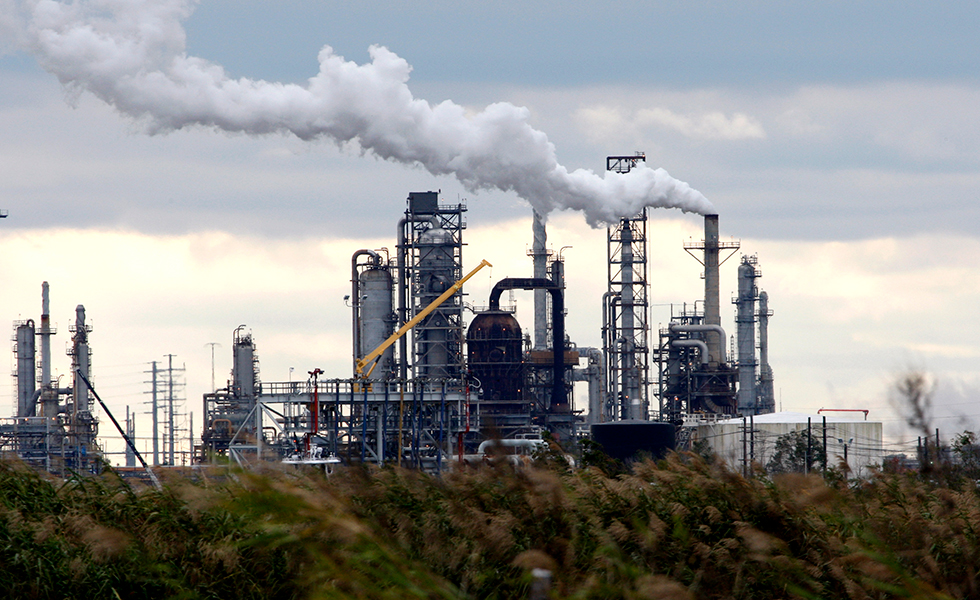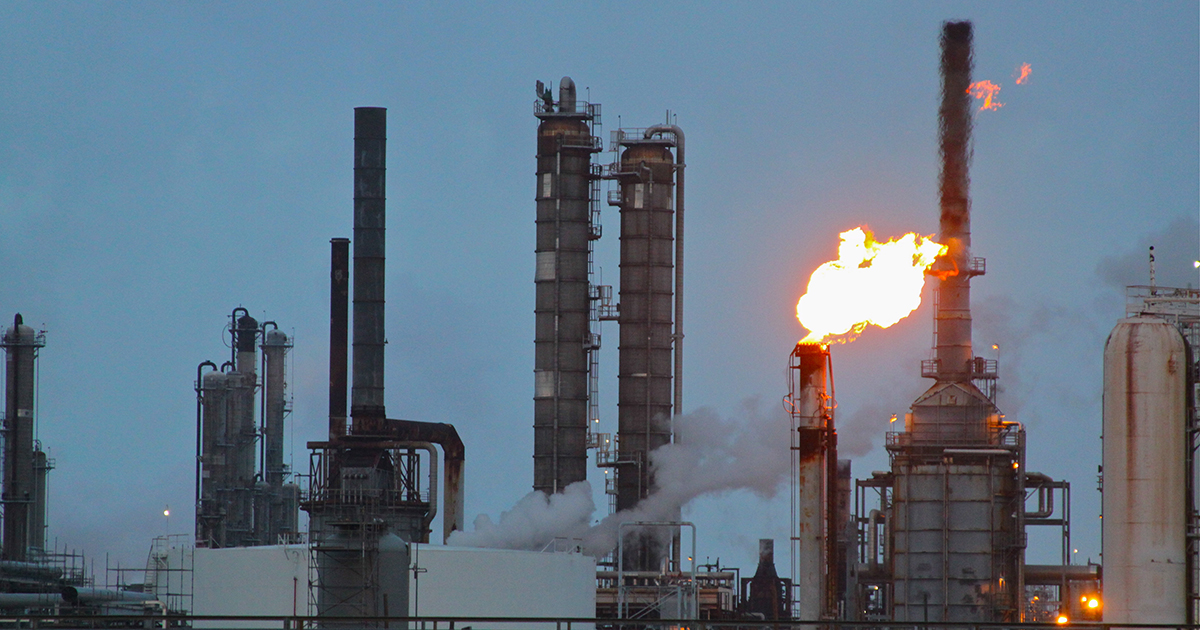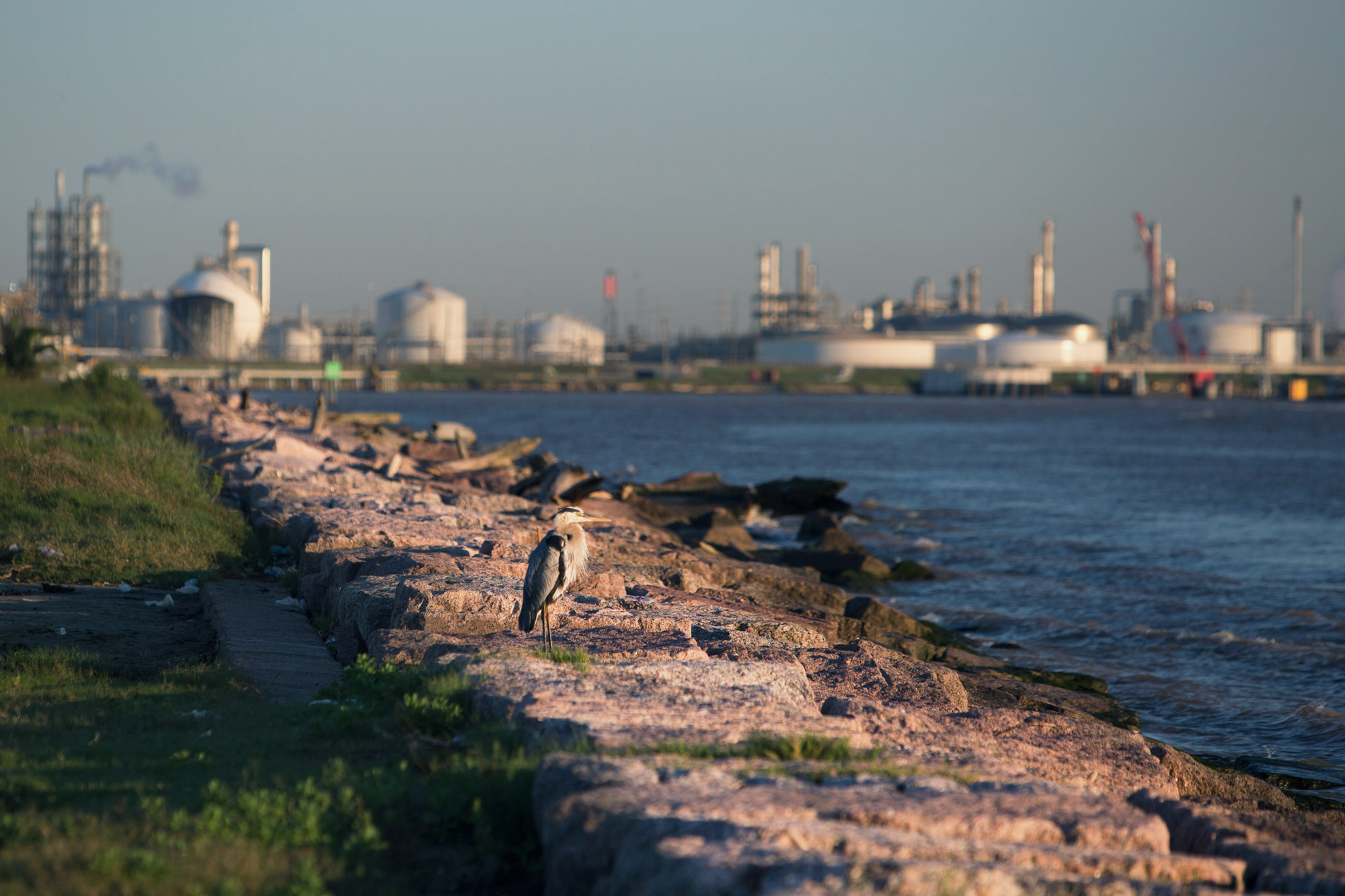
Six Texas Oil Refineries Are Among the Nation’s Worst Benzene Polluters, Data Shows
Benzene was detected at the facilities’ fencelines, and nearby communities could be exposed to the cancer-causing pollutant.

The 367-mile Texas Gulf Coast now holds an unenviable honor: It is home to six of the nation’s most prolific polluters of benzene, an invisible, deadly gas that elevates cancer rates. The finding was announced Thursday by the Washington, D.C.-based Environmental Integrity Project, which spent months poring over data submitted to the federal government by U.S. oil refineries as part of a nascent air pollution monitoring program.
A component of crude oil, gasoline, and cigarette smoke, benzene is a carcinogen that can also contribute to respiratory disease and developmental delays in infants. While outsized benzene emissions along Texas’ heavily industrialized Gulf Coast have been in the public eye since at least the late 1990s, the new data offers a glimpse into how the pollution may impact the working-class neighborhoods near refineries. The report comes on the heels of a series of disasters at Texas facilities associated with the petrochemical industry.
“This report shows that almost half of the refineries with the most cancer causing benzene emissions in the U.S. are right here in Houston’s backyard,” said Bakeyah Nelson, Executive Director of Air Alliance Houston. “Governor Abbott needs to get serious about this issue today and direct the Texas Commission on Environmental Quality to crack down on this dangerous pollution.”
Minorities and the working class often suffer the consequences of severe air pollution along the Gulf Coast, especially in communities that straddle the Houston Ship Channel.
Perhaps the worst offender in Texas was the Total Petrochemicals refinery in Port Arthur. That facility was the state’s biggest monitored emitter of benzene through the first three quarters of 2019 (the time period for EIP’s analysis). Benzene levels at its fenceline were measured at 148 percent above the Environmental Protection Agency’s “action level”—the point at which a company should investigate—of nine micrograms per cubic meter of air. The hulking petrochemical complex gobbles up several city blocks at Port Arthur’s northeastern edge and can pump out 174,000 barrels of crude oil each day. That’s good for business, but bad for the folks who live nearby, advocates say. Total Petrochemicals is bordered by residential neighborhoods that have been repeatedly exposed to benzene by the refinery. The city of Port Arthur is one of Texas’ best-known examples of how rampant air pollution can harm a predominantly minority population, even compared to other heavily polluted coastal communities.
Pasadena Refining, located just southeast of Houston and 80 miles west of Port Arthur, had the second-highest levels of benzene among Texas refineries included in the report. The facility emitted benzene at twice the EPA limit, data shows. Flint Hills Resources and Valero, both in Corpus Christi, were 79 percent over and 44 percent over, respectively; the Shell refinery in Deer Park was 23 percent over and Marathon’s facility in Texas City surpassed the threshold by 11 percent.
Historically, the Texas coast has seen some of the state’s most egregious benzene pollution. In 2002, a federal judge sentenced two men who operated chemical facilities in Port Neches and Port Arthur to three years in prison after a state inspector discovered “off the charts” levels of benzene emissions. A 2008 Texas A&M study found that some Corpus Christi residents living adjacent to a Citgo refinery had benzene levels 280 times the general population in their blood and urine. And as Hurricane Harvey bore down on the coast in 2018, coastal refineries leaked between 1,880 and 28,500 pounds of benzene into the air. (That number may be higher, but state regulators gather little emissions data independently, instead allowing industry to self-report its pollution releases.)

Minorities and the working class often suffer the consequences of severe air pollution along the Gulf Coast, especially in communities that straddle the Houston Ship Channel. Children living within two miles of the channel are 56 percent more likely to contract leukemia, according to the University of Texas School of Public Health. It’s no wonder that the Upper Gulf Coast, which comprises Harris, Brazoria, Jefferson, and a couple other counties, is sometimes referred to as the state’s cancer belt.
In a statement, an EPA spokesperson told the Observer that high concentrations of benzene measured at refinery fencelines don’t always translate to pollution in surrounding neighborhoods. But, “If exceedances of the action level are ongoing, this may be a flag for EPA to do further analyses regarding potential community risk,” the spokesperson said.
The state environmental agency, however, has done little to slow the pace of emissions. In 97 percent of all cases of unauthorized pollution releases, TCEQ allows polluters to exploit a loophole that protects them from punishment. ExxonMobil’s Baytown Complex took advantage of that for years, claiming that its pollution was the result of unavoidable circumstances. Meanwhile, the company spewed massive volumes of benzene and other pollutants into the air. A 2018 Observer investigation revealed that TCEQ handles corporate offenders with kid gloves while strictly enforcing rules on small businesses.
The new monitoring data is more evidence that dangerous emissions from refineries are creeping across the facilities’ property lines to homes, businesses, parks, and schools. The data may never have materialized, however, if not for a 2012 lawsuit in which EIP charged that EPA had failed to update and review air pollution standards for oil refineries for at least a decade. As a result, in 2018, EPA required refineries to monitor benzene emissions at their fencelines to get a sense of the volume of pollutants wafting into adjacent neighborhoods. Refineries are now required to take air samples at the perimeter of their properties twice a week; if benzene levels are over the EPA threshold, the refinery must investigate.
The report suggests that the new monitoring may be helping to reduce emissions. Benzene releases at the Valero refinery in Corpus Christi, for example, were above the action level for most of 2019, but the company was able to keep them under the limit late in the year. “It appears that the fenceline program is working as intended to identify problems,” the report reads.
It’s probably ambitious to hope that this new monitoring program will usher in a new era of corporate responsibility at Texas’ dirtiest refineries, or that it’ll finally force TCEQ to hold rulebreakers to account. But perhaps it could pressure refiners to pay more attention to the pollutants that are leaving their property lines—and that could allow their neighbors to breathe a much-needed sigh of relief.
This story has been updated to include a quote from the EPA.
Read more from the Observer:
-
Something in the Air: In the Texas Panhandle, which produces a fifth of the U.S. beef supply, communities are being choked by fecal dust from nearby feedlots. The state’s regulatory agency isn’t doing anything about it—and it’s about to get a whole lot worse.
-
Researcher Jeremy Slack on the Horrors that Await Immigrants Deported from the U.S.: Slack led a massive research effort to learn what happens to those whom immigration authorities deport and dump all along the Mexican border.
-
An Incendiary New Book Reveals How Politics in El Paso Are Rigged: Who Rules El Paso? shows how a coterie of rich, primarily white Republicans control local government.


